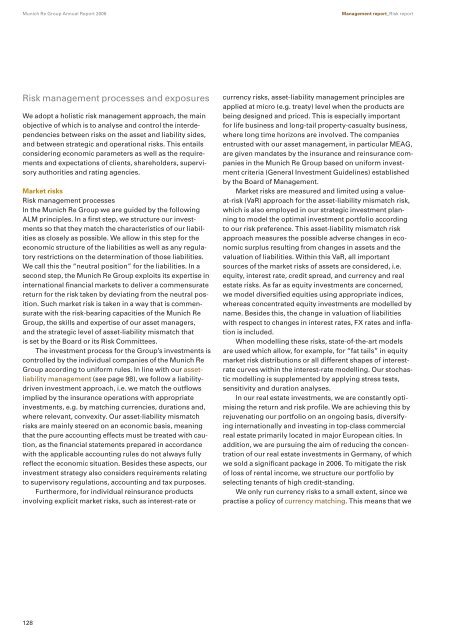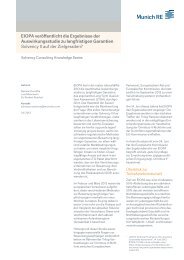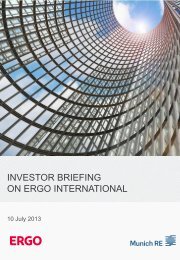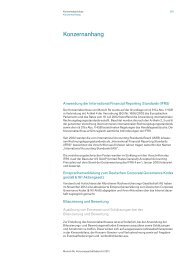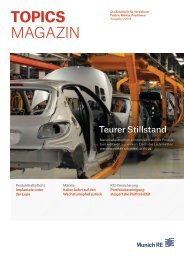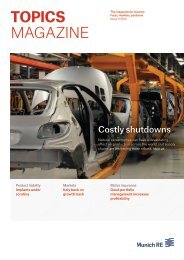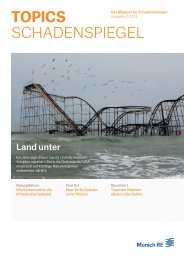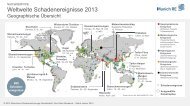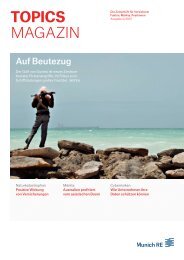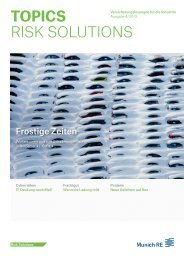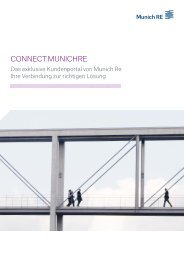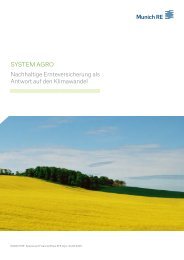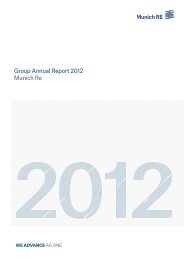Munich Re Group Annual Report 2006 (PDF, 1.8
Munich Re Group Annual Report 2006 (PDF, 1.8
Munich Re Group Annual Report 2006 (PDF, 1.8
Create successful ePaper yourself
Turn your PDF publications into a flip-book with our unique Google optimized e-Paper software.
<strong>Munich</strong> <strong>Re</strong> <strong>Group</strong> <strong>Annual</strong> <strong>Re</strong>port <strong>2006</strong><br />
Risk management processes and exposures<br />
We adopt a holistic risk management approach, the main<br />
objective of which is to analyse and control the interdependencies<br />
between risks on the asset and liability sides,<br />
and between strategic and operational risks. This entails<br />
considering economic parameters as well as the requirements<br />
and expectations of clients, shareholders, supervisory<br />
authorities and rating agencies.<br />
Market risks<br />
Risk management processes<br />
In the <strong>Munich</strong> <strong>Re</strong> <strong>Group</strong> we are guided by the following<br />
ALM principles. In a first step, we structure our investments<br />
so that they match the characteristics of our liabilities<br />
as closely as possible. We allow in this step for the<br />
economic structure of the liabilities as well as any regulatory<br />
restrictions on the determination of those liabilities.<br />
We call this the “neutral position” for the liabilities. In a<br />
second step, the <strong>Munich</strong> <strong>Re</strong> <strong>Group</strong> exploits its expertise in<br />
international financial markets to deliver a commensurate<br />
return for the risk taken by deviating from the neutral position.<br />
Such market risk is taken in a way that is commensurate<br />
with the risk-bearing capacities of the <strong>Munich</strong> <strong>Re</strong><br />
<strong>Group</strong>, the skills and expertise of our asset managers,<br />
and the strategic level of asset-liability mismatch that<br />
is set by the Board or its Risk Committees.<br />
The investment process for the <strong>Group</strong>’s investments is<br />
controlled by the individual companies of the <strong>Munich</strong> <strong>Re</strong><br />
<strong>Group</strong> according to uniform rules. In line with our assetliability<br />
management (see page 98), we follow a liabilitydriven<br />
investment approach, i.e. we match the outflows<br />
implied by the insurance operations with appropriate<br />
investments, e.g. by matching currencies, durations and,<br />
where relevant, convexity. Our asset-liability mismatch<br />
risks are mainly steered on an economic basis, meaning<br />
that the pure accounting effects must be treated with caution,<br />
as the financial statements prepared in accordance<br />
with the applicable accounting rules do not always fully<br />
reflect the economic situation. Besides these aspects, our<br />
investment strategy also considers requirements relating<br />
to supervisory regulations, accounting and tax purposes.<br />
Furthermore, for individual reinsurance products<br />
involving explicit market risks, such as interest-rate or<br />
128<br />
Management report_Risk report<br />
currency risks, asset-liability management principles are<br />
applied at micro (e.g. treaty) level when the products are<br />
being designed and priced. This is especially important<br />
for life business and long-tail property-casualty business,<br />
where long time horizons are involved. The companies<br />
entrusted with our asset management, in particular MEAG,<br />
are given mandates by the insurance and reinsurance companies<br />
in the <strong>Munich</strong> <strong>Re</strong> <strong>Group</strong> based on uniform investment<br />
criteria (General Investment Guidelines) established<br />
by the Board of Management.<br />
Market risks are measured and limited using a valueat-risk<br />
(VaR) approach for the asset-liability mismatch risk,<br />
which is also employed in our strategic investment planning<br />
to model the optimal investment portfolio according<br />
to our risk preference. This asset-liability mismatch risk<br />
approach measures the possible adverse changes in economic<br />
surplus resulting from changes in assets and the<br />
valuation of liabilities. Within this VaR, all important<br />
sources of the market risks of assets are considered, i.e.<br />
equity, interest rate, credit spread, and currency and real<br />
estate risks. As far as equity investments are concerned,<br />
we model diversified equities using appropriate indices,<br />
whereas concentrated equity investments are modelled by<br />
name. Besides this, the change in valuation of liabilities<br />
with respect to changes in interest rates, FX rates and inflation<br />
is included.<br />
When modelling these risks, state-of-the-art models<br />
are used which allow, for example, for “fat tails” in equity<br />
market risk distributions or all different shapes of interestrate<br />
curves within the interest-rate modelling. Our stochastic<br />
modelling is supplemented by applying stress tests,<br />
sensitivity and duration analyses.<br />
In our real estate investments, we are constantly optimising<br />
the return and risk profile. We are achieving this by<br />
rejuvenating our portfolio on an ongoing basis, diversifying<br />
internationally and investing in top-class commercial<br />
real estate primarily located in major European cities. In<br />
addition, we are pursuing the aim of reducing the concentration<br />
of our real estate investments in Germany, of which<br />
we sold a significant package in <strong>2006</strong>. To mitigate the risk<br />
of loss of rental income, we structure our portfolio by<br />
selecting tenants of high credit-standing.<br />
We only run currency risks to a small extent, since we<br />
practise a policy of currency matching. This means that we


